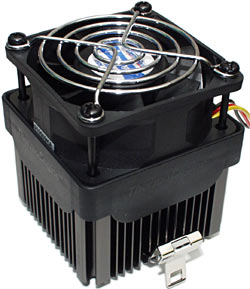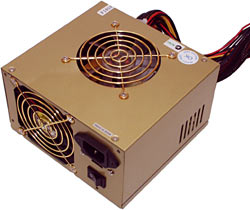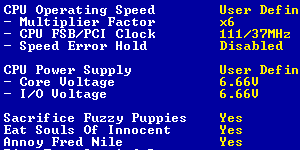
Atomic I/O letters column #7
Originally published in Atomic: Maximum Power Computing Reprinted here 2-May-2002.Last modified 16-Jan-2015.
Invisible drive
When I added a new Ricoh 12x10x32 IDE CD burner to my PC (based on an Asus A7V-E motherboard with an 800MHz Duron CPU), nothing showed up about it, it just says "IDE Secondary: None". I checked that the jumper at the back of the burner was set to slave and that all the cables were stuck in. So I decided to take it back to the shop I bought it from to see if the burner is broken in any way, but they stuck it on their PC and it worked fine. I have tried some forums but none had anything about this, so could you please help me?
Steven Xue
Answer:
Assuming the drive's correctly connected, your problem is probably caused
by that particular drive "location" being hard-set to "None" in your BIOS
setup. Many normal two-IDE-connector PC motherboards come with up to three
of their four possible IDE drive locations disabled, in the name of faster
boot times.
Press Delete at the beginning of the boot process to get into the BIOS setup program (some brand name PCs use a different key, but most motherboards use Delete), and in the Main menu you see when the setup program starts, make sure all four IDE locations are set to "Auto" and not "None". Go into the submenu for each one and check; some BIOSes aren't as obvious about this as they should be.
If, say, Secondary Slave is set to Auto and there's no actual secondary slave drive, it just means the computer will take a few more seconds to boot, as it looks for a drive where one isn't to be found. But if some location is set to None, then the computer won't look for a drive there at all.
Toasty T-Bird
I'm currently running an Athlon T-Bird 1.2GHz with a ThermoEngine cooler on an ASUS A7V133 board. What's the problem I hear you ask? Using the ASUS Probe utility my CPU is registering a temperature between 52 and 58 degrees. I currently have a front intake fan and a rear exhaust fan, both of which are 80mm and operating at approximately 6000 RPM. What can I do?
Simon Crow

A ThermoSonic ThermoEngine CPU cooler, as reviewed
here. This one comes standard with a high
speed Y.S. Tech fan, and works about as well as any air cooler you can buy.
Answer:
Well, you can stop worrying, if the computer doesn't hang all the time.
If it does, then you've got a problem, and heat may well be it. If it always takes a little while before the computer crashes and then it does it over and over, or if it does it more in hot weather, then heat's probably the culprit. Take the lid off the computer and point a desk fan at the motherboard and see if the problem goes away.
If so, then more ventilation and/or a better cooler is not a bad idea.
Or you can just leave the desk fan there all day.
But a 1.2GHz Thunderbird Athlon is a warm CPU even with a decent cooler on it. The older standard-model ThermoEngine with its low profile stock fan isn't an especially amazing cooler, and so a high-ish CPU temperature can be expected. If you've got the newer kind of ThermoEngine, which comes with a high power full height fan on it (or if you've got an older one with a big fan retrofitted to it), then you won't be able to get a much better air cooler at any price. Switching from the stock thermal gum on the base of the ThermoEngine to a super-thin layer of thermal grease might still help a bit.
Your motherboard thermal sensor isn't telling you what the temperature of the core is, anyway. You don't know anything much about the heat path from the core to the probe in the middle of the CPU socket. The calibration of the sensor monitor hardware is another unknown factor; just because your monitoring software says "55 degrees" doesn't mean that's the real temperature of the sensor. It's probably pretty much right, but calibration can be massively off in some cases, and can change when you update your BIOS.
Getting back to the main point, though - if the computer doesn't hang all the time, don't worry about it.
Power problems?
I have a AMD Athlon AXIA 1.2gigs with a GeCool GeTM2 7000rpm orb HSF, Asus A7A266 (BIOS version 04/30/2001), 256MB of Hyundai PC-133 SDR-SDRAM, Seagate Barracuda UDMA66 8.5Gb HDD, a Sound Blaster Live! Value, a Creative Infra60 40x CD-ROM, and a good 250W PSU. This PC is running Win98SE OEM full version with all the latest drivers for everything I can think of. Yesterday, I got rid of my Voodoo 3 3000 and went out and got a 3D Power GeForce3 Morpheus and installed the new 12.41 divers for it. The CPU operates around 50 degrees (give or take 5 or so depending on what you are doing). When I play some games, I get a lot of lockups, cashes and system rebooting. With some games it is not as bad (like the Q3:A demo) but with others, it is every 5 minutes. In Windows, like in Word, email or on the web, everything is fine (by Windows standards that is!). I had the same problem with my old graphics card.
What the hell is going on with my beast?! Is it just Windows being Windows or do I have static damage on the mobo? Or is it something else? Help!
Alftura

"Topower make some well priced high power PSUs. This one, reviewed
here, has 420 watt output.
Answer:
My guess would be that you need a better PSU. A cheap "300W" PSU is not,
necessarily, better than a good 250W unit, and neither is likely to be up
to the task of running a steaming Athlon box.
A quality 300W supply would probably do, but you can get higher-rated units for not a lot more money. Enermax and Topower make a variety of 350W and higher rated PSUs. Prices start from around the $AU110 mark (delivered price) for the Topower PSUs, and around the $AU150 mark for the Enermax PSUs.
Why so slow?
I've got a PC with an Asus A7V133 motherboard and 1GHz AXIA Athlon CPU. Everything is running fine, except that whenever I try to do something it takes all of my CPU power - everything just stops and goes to the program that I'm opening. When I look at System Properties, the Performance section tells me that all of my drives are "using MS-DOS compatibility mode file system".
Could I have formatted my drive wrong? Or do I need another hard drive to fix this?
Gotek
Answer:
You've probably forgotten to install the Via chipset drivers that came with
the motherboard. You can get the latest version of the Via "4-in-1" driver
package from here.
Microsoft mention this in their support page here, and there are hints for resolving various other causes of the same symptoms here.
Gone, all gone
I just took my computer in to get an upgraded motherboard. They said because of incompatibility problems they would have to re-install Windows. When I got the PC home they had deleted all my programs from the hard drive, and just left a new version of Windows. I rang them to find out and they said they had to because of incompatibility between the chipsets. They didn't back up, everything is now gone. Are they telling the truth or was I ripped off? Is this going to happen if for example I got an Athlon CPU and motherboard in the future?
David McMahon
Answer:
A new motherboard shifts a lot of low-level stuff around, not to mention
changing the basic system drivers that need to be installed, so you usually
have to reinstall Windows to make it work. It may be possible to reinstall
Windows over the top of itself after a motherboard change, but doing that
may also leave you with a messed up system.
If someone installing a new motherboard formats the PC's hard drive before they reinstall Windows, then yes, all of the data on that drive will be gone. But if they just zap the Windows directory and then install the OS again, then your files are still there (your applications will be in C:\Program Files\, by default), but Windows doesn't know about them.
In a situation like this, a fair few programs will keep all of your old settings if you just reinstall them again. Alternatively, you can back up the program directories, do a clean install of your applications, then restore the program directories back on top of the new installs.
Of course, there's no drama here anyway, because you backed up your data, didn't you? Everybody knows that data you haven't backed up is data that you don't want to keep, after all.
So you can just restore your data, and be in business once more.
Hello?
David?
How to lose your Net access
I am normally a Big Pond cable user, but Telstra cut off my Internet access because they said I was running a mail server. After many phone calls and faxes, Telstra security outlined a problem they have experienced with some users connected to the net with port 25 (mail server) open. This has allowed spammers access to the server, which they have flooded with spam. I have been advised to close my port 25 and give them a guarantee that it will remain closed before they will reconnect me.
They obviously assume that all users of the Telstra network are fully conversant with all aspects of computing as they have given no instruction as to how this is achieved. Could you please advise me of the best procedure for ensuring port 25 is blocked and how I might prove this to Telstra when it is achieved? The last thing I want is to be in any way responsible for allowing hackers free rein!
David Graham-Eagle.
Answer:
The only way in which having TCP port 25 open would be a problem is if you
were running mail server software. The port can be thought of as, say, the
door to one flat in an apartment block. Burglary is only a risk if there's
actually stuff to steal in that particular flat. If nobody lives there,
nothing can be stolen, whether the door's left locked or not.
Likewise, allowing people to query port 25 on a computer that's not running a mail server will do nothing. It doesn't magically cause a mail server to appear.
If you are running a mail server, though, things are different. The default configuration for some mail servers allows them to work as an "open relay". When you're running an open relay, anybody on the whole Internet who knows your IP address - and spammers scan ranges of IP addresses all the time looking for open relays - can just log into your computer and send mail to anybody, from anybody, at least as far as the mail headers go. The amount of mail they can send is only limited by the speed of your computer and the speed of your Internet connection.
When a professional spammer does this to someone who ran an open server by accident, an avalanche of complaint mail from recipients will go to the server operator's ISP, and their account will generally be summarily pulled. Which is what seems to have happened to you.
You don't mention what version of Windows you're running, and you don't mention having more than one computer connected to the Internet, so I presume you haven't been fooling around with Linux. There are many mail server packages for Windows. Most Windows mail servers do not, by default, act as an open relay, but some still do.
You don't have to have an open server to get booted off Big Pond Cable, though; just running any kind of server, no matter how well secured, is technically a violation of the Acceptable Use Policy. Not that Telstra are likely to know or care, if whatever server you run results in little data being transferred.
Still chasin' Satan
In your "Aleister Crowley computing" reply in an earlier column, when you said "But you're not ever going to get a '666MHz' boot up speed display, unless there's a '133.2MHz' FSB option on your board", you were wrong. I have an AOpen AX6BC motherboard, and you can set the bus to 148MHz and the multiplier to 4.5 which gives you 666MHz. I only have a PIII-450, and it won't boot up to that, but a friend of mine with a 700 says his boots fine.
Kallus

I spent some time making this image. The least you can do is click
it and see the full thing.
Answer:
Well, unless your friend has a non-retail manufacturing-sample P-III, I
doubt it. No retail or OEM P-III has an unlocked multiplier. It doesn't
matter what you set in the BIOS configuration - the real multiplier stays
the same. So if you asked for 4.5 X 148MHz with a normal 700MHz P-III, you
might get a boot-up display that said 666MHz; that depends on how your motherboard's
BIOS works. But the CPU would still actually be running at its stock 7X
multiplier, for a core speed above 1GHz.
Getting a 48% overclock like this out of a P-III isn't impossible, but it's very unlikely to work with anything short of cryogenic cooling.
If your friend's CPU is actually a P-III 733EB, which is made to work from 5.5 X 133MHz (the "B" in the name indicates the 133MHz FSB), then I wouldn't be surprised if it could tolerate 148MHz FSB, which would give it a bit more than 800MHz, real core speed.
Your basic point, though, is correct. If you can get your computer running stably at 148MHz FSB, then a 4.5X multiplier will indeed give you a 666MHz core speed. 148MHz FSB is likely to be an adventure all its own on an AX6BC, which uses the Intel i440BX chipset and will, at that FSB, be trying to run its AGP bus 48% above rated speed, but never mind.
Finding an CPU that'll run at that speed combination will be something of a challenge. The minimum multiplier for AMD Athlons and Durons is 5X, so they're out. But I suppose it depends on what the Dark Lord commands of you.
To more easily comply with the requirements of He Who Cannot Be Named, 6 X 111MHz ought to be fine with pretty much any 600MHz P-III. 9 X 74MHz will work as well, but that's a pretty inelegant combination.

